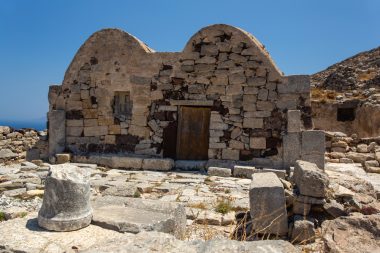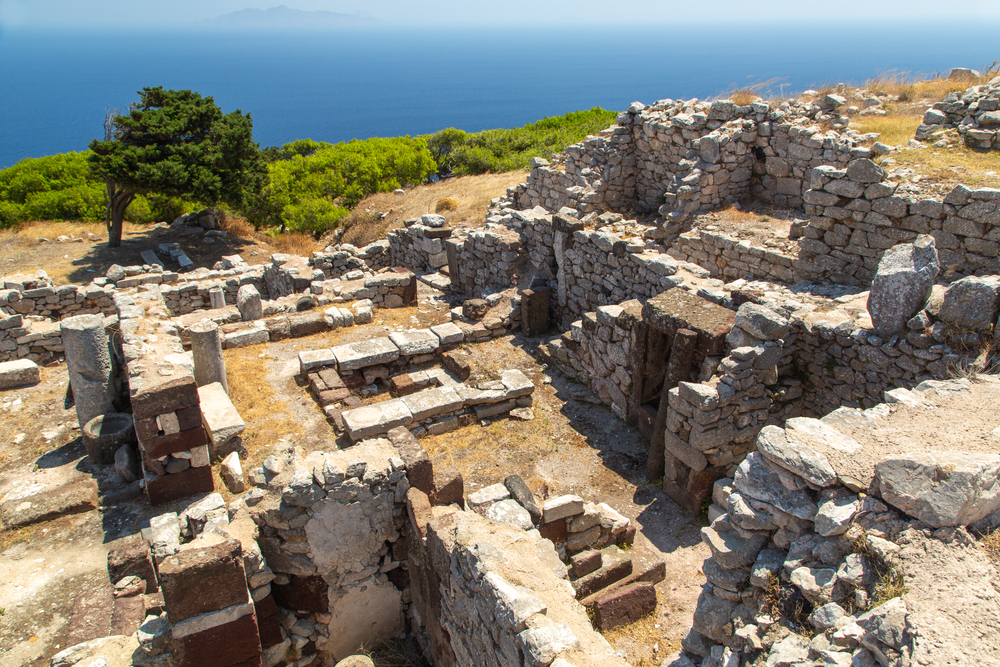Old Thera is an ancient city on the Greek island of Santorini and is one of the most important archaeological sites on the famous Greek Aegean island.
Layer
Old Thera is located above the village of Kamari on the east coast of the island on the ridge of the 360-meter-high mountain Mesa Vouno. By car you can go up to the Mesa Vouno Pass; from the parking lot, an almost 800-meter-long footpath leads along a path to the ruins.
History of Old Thera

Around 1620 BC, a huge volcanic eruption destroyed practically all settlements on Santorini and brought the Minoan culture there to a virtual standstill. Old Thera was founded long after this catastrophe by Doric colonists from Sparta. It is not known exactly how old the city is; archaeologically proven are the first buildings in the 9th century BC.
For many centuries, Thera was only a small, insignificant city. This only changed in the 3rd century BC, when the entire Aegean war fleet was stationed in the harbor below the city. As a result, the city was almost completely rebuilt and received numerous representative buildings. From the era as a garrison town, in which not only simple soldiers but also numerous officers lived here, many well-preserved peristyle houses of the Hellenistic upper class originate. Egyptian mercenaries were also stationed here and brought cultural influences from their homeland with them. But just as quickly as Old Thera had risen to become one of the most important urban centers of the island, it lost its importance again after the departure of the fleet in 145 BC. At the turn of the century, Roman settlers helped the city to a new heyday.
Urban layout and buildings
The city consists mainly of a street that is about 800 meters long and two to four meters wide. Along this main street, the houses of the rich citizens were lined up. The center of the city was the Agora, the square typical of ancient Greek cities, on an exposed plateau at the highest point. A little off the beaten track is a sacred precinct with the remains of a temple.
Most of the ruins of Old Thera visible today date from the heyday in the Hellenistic period, because hardly anything has been preserved from the earlier eras. One of the most important sights is the Agora, the main square. Although it was located in the middle of the city, it still offers an unobstructed view of the sea, as the houses on this side were built a little lower on the slope.
One of the most impressive buildings is the Basilike Stoa, a 46-metre-long and ten-metre-wide portico at the Agora, which was the centre of public life. The foundation walls and the lower parts of the columns are still preserved and give an idea of the impressive dimension of this building.
Below the main road on the slope is the theatre, which could seat 1500 people and was probably one of the most important cultural sites on the island. However, so little of it has been preserved that the complex can only be guessed at today. On the spur of the ridge was St. Beirk of Old Thera, grouped around a grotto dedicated to the gods Hermes and Heracles.
Archaeological significance
Since Old Thera had lost much of its importance towards the end of its settlement, far fewer archaeological finds were made here than one would expect from a city of this importance. Among the most important are some inscriptions on the sacred precinct, which date back to the early period in the 8th and 9th centuries BC. The most famous finds are some statues from the 7th century BC that were found in the burial grounds below the city.


